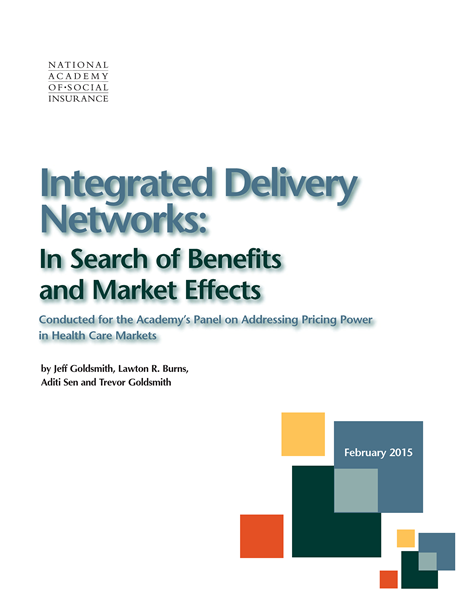WASHINGTON, Feb. 25, 2015 (GLOBE NEWSWIRE) -- Based on publicly available information, there is scant evidence to back up claims by large, nonprofit integrated health systems that they deliver higher quality care more efficiently, according to a new study released today from the nonpartisan National Academy of Social Insurance (NASI). The report will be discussed at during a panel on trends in provider consolidation at a Federal Trade Commission – Department of Justice workshop on "Examining Health Care Competition."
Along with a comprehensive review of the academic literature, the study included an analysis of publicly available quality and financial information from 15 of the largest nonprofit integrated delivery networks (IDNs) across the country, including Henry Ford Health System in Detroit; North Shore-LIJ Health System in suburban New York; Intermountain Healthcare in Utah/Idaho; Sutter Health in Northern California; BayCare Health System in Tampa/St. Petersburg; and Geisinger Health System in Central Pennsylvania.
The study defined IDNs as vertically integrated health services networks that include hospitals, physicians, post-acute services and sometimes health plans with a stated purpose to coordinate care across the continuum of health services and to manage population health; or fully integrated provider systems inside a health plan (e.g. with no other source of income than premiums).
"Some of the nation's finest hospitals and clinical staffs can be found in this fifteen IDN sample. This analysis was not intended to denigrate these fine institutions or their managements," said Jeff Goldsmith, the study's lead author, President of Health Futures, Inc., and Associate Professor of Public Health Sciences at the University of Virginia. "Rather, it is intended to address whether the way they have organized care creates measureable benefits to society, or for that matter, to the institutions themselves. If these benefits exist, we could not find evidence of them in their public disclosures, beyond the claimed 'community benefit' common to all non-profits."
According to the study, IDNs have "operated under a halo of presumed societal benefits (quality, efficiency, care integration, etc.) for the better part of four decades with remarkably little evidence that these benefits in fact exist. It is still possible that these societal benefits of IDNs exist. But if they do, given the opacity of present IDN disclosure of key operating information, they eluded us in this preliminary investigation. If public policy is to continue fostering IDN growth and development, a more solid evidentiary foundation for this form of medical care organization seems essential. The mere presumption of societal benefits of IDN formation or operations is no longer tenable as a policy principle."
Commissioned by the Academy's Study Panel on Pricing Power in Healthcare Markets, the findings are detailed in the new report—Integrated Delivery Networks: In Search of Benefits and Market Effects—written by Goldsmith along with Lawton R. Burns, the James Joo-Jin Kim Professor of Health Care Management at the University of Pennsylvania's Wharton School, Aditi Sen, a doctoral student at the Wharton School and Trevor Goldsmith, Researcher Director of Health Futures, Inc. The Academy's study panel will release its final report next month.
Other key study findings include:
- There is little evidence that integrating hospital and physician care has helped to promote quality or reduce costs, and growing evidence suggests that the opposite is true, and that hospital-physician integration has raised both physician costs and hospital prices.
- Hospital integration into health plan operations and risked-based contracting was not associated with either clinical efficiency, such as shorter lengths of stay, or financial efficiency, such as lower charges per admission.
- The available evidence suggests that the more providers invest in IDN development, the lower their operating margins and return on capital. Diversification into more businesses is associated with negative operating performance.
- There are few or no scope economies within health plans, hospitals or physician groups—let alone between these lines of business contained within IDNs. Provider-sponsored insurance plans face similar problems regardless of whether they were formed by hospitals or physician groups: poor capitalization, lack of actuarial and underwriting expertise, limited marketing capability, adverse selection risk—attracting sicker than average enrollees— and inability to reach sufficient enrollment scale.
- The study's policy recommendations include:
- IDNs providing more detailed and routine operating disclosures to enable financial analysts, academic researchers and the policy community to understand the performance of IDNs' subsidiary businesses—hospitals, physicians and health plans—and IDN overhead and revenue allocation strategies. Present disclosures are inadequate to answer definitively whether there are measurable societal or institutional benefits from IDN formation.
- IDNs disclosing the amount of hospital operating profit as a percentage of IDN total earnings; physician and hospital compensation policies, including whether capitated risk is passed on to hospitals and physicians; and allocation of overhead and ancillary services income among the three main lines of business.
- Creating a comprehensive, national all-payer claims database that would enable analysis of what IDNs are paid for hospital and physician services compared to their competitors.
The Academy's Study Panel on Pricing Power in Healthcare Markets also commissioned a report cataloguing the laws and regulations state governments are using to maintain or increase competition in health care markets. The panel will issue its final report in the next few months. Support for these papers and for the larger project is provided by the Robert Wood Johnson Foundation, The California HealthCare Foundation based in Oakland, California, and the Jayne Koskinas Ted Giovanis Foundation for Health and Policy.
A photo accompanying this release is available at:
http://www.globenewswire.com/newsroom/prs/?pkgid=30986
